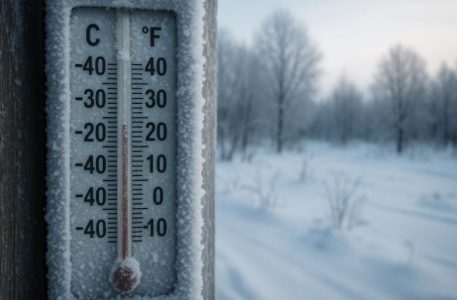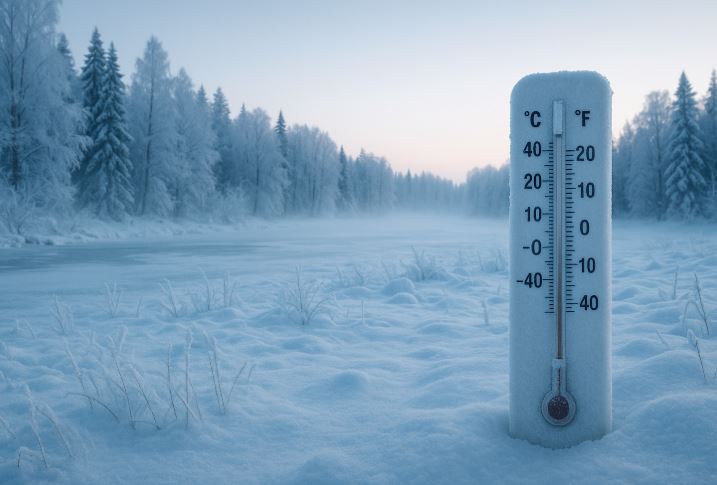Have you ever checked the weather and seen –40° on the forecast, only to wonder whether that’s Celsius or Fahrenheit, and which one is colder?
It’s a surprisingly common question, especially for travellers or those curious about science. Interestingly, at –40°, both temperature scales align perfectly.
That’s right, minus 40°C and minus 40°F are exactly the same. Let’s explore how these two vastly different systems meet at this fascinating temperature.
Why Do We Use Different Temperature Scales Around the World?
Temperature affects everything, from weather forecasts to cooking instructions and scientific research. Depending on where you are in the world, you’ll come across two main units of temperature: Celsius (°C) and Fahrenheit (°F).
While Celsius is widely used in most parts of the globe, including India, Europe, and Australia, Fahrenheit remains the standard in countries like the United States.
These two scales were created centuries ago by scientists from Europe. The Fahrenheit scale was developed by Daniel Gabriel Fahrenheit, a Dutch physicist, in the early 1700s.
Shortly after, Anders Celsius, a Swedish astronomer, introduced the Celsius scale. While they were both intended to measure temperature, their reference points and increments differ significantly.
What Makes Celsius and Fahrenheit So Different?

The fundamental difference between the Celsius and Fahrenheit scales lies in how they define the freezing and boiling points of water:
| Scale | Freezing Point | Boiling Point |
| Celsius | 0°C | 100°C |
| Fahrenheit | 32°F | 212°F |
As the table shows, the Celsius scale is based on a 100-degree range between freezing and boiling, whereas the Fahrenheit scale uses 180 degrees for the same range. This makes each Celsius degree larger than a Fahrenheit degree, approximately 1.8 times bigger.
This discrepancy means that although both scales measure the same physical property, temperature, the numbers they assign to the same condition can look very different.
How Do You Convert Celsius to Fahrenheit (and Vice Versa)?
Understanding the difference between the two scales is one thing; converting between them is another. Luckily, there’s a straightforward formula for both:
- To convert Celsius to Fahrenheit:
F=(1.8×C)+32F = (1.8 \times C) + 32F=(1.8×C)+32
- To convert Fahrenheit to Celsius:
C=(F−32)÷1.8C = (F – 32) \div 1.8C=(F−32)÷1.8
For example:
- Converting -40°C to Fahrenheit:
F=(1.8×−40)+32=−72+32=−40°FF = (1.8 \times -40) + 32 = -72 + 32 = -40°FF=(1.8×−40)+32=−72+32=−40°F
- Converting -40°F to Celsius:
C=(−40−32)÷1.8=−72÷1.8=−40°CC = (-40 – 32) \div 1.8 = -72 \div 1.8 = -40°CC=(−40−32)÷1.8=−72÷1.8=−40°C
So, both formulas lead us to the same remarkable conclusion: -40°C = -40°F.
What’s Special About Minus 40 Degrees?
Out of all the possible temperatures on the Celsius and Fahrenheit scales, -40 is the only point where the two scales intersect. This means that if you ever see -40° on a thermometer, it doesn’t matter if the scale is Celsius or Fahrenheit, it’s the exact same temperature.
But how is this possible? It comes down to how the two scales are constructed. The larger size of Celsius degrees compared to Fahrenheit degrees means that they move at different rates. At a certain point, in this case, -40°, they meet.
It’s a bit like two people walking toward each other from opposite ends of a track at different speeds: eventually, they will pass each other.
Which is Colder: Minus 40°C or Minus 40°F?

This question often pops up when people travel internationally or read global weather reports. The short answer?
Neither is colder, they are exactly the same.
At minus 40, both Celsius and Fahrenheit scales display identical numerical values, making it a unique and rare overlap in the world of science. While many people assume Fahrenheit values are always higher than Celsius, this point is a significant exception.
How Can Algebra Prove This Temperature Crossover?
If you’re curious about the math behind this phenomenon, it can be shown using basic algebra. Let’s find the value at which Celsius and Fahrenheit temperatures are equal by solving the following equation:
Let x be the temperature where both scales are the same.
Step 1
Use the Celsius-to-Fahrenheit conversion formula:
x=(9/5)x+32x = (9/5)x + 32x=(9/5)x+32
Step 2
Bring terms to one side:
x−(9/5)x=32x – (9/5)x = 32x−(9/5)x=32 (1−9/5)x=32(1 – 9/5)x = 32(1−9/5)x=32 (−4/5)x=32(-4/5)x = 32(−4/5)x=32
Step 3
Solve for x:
x=32×−54=−40x = \frac{32 \times -5}{4} = -40x=432×−5=−40
So, the crossover temperature is -40°C = -40°F. The same proof works in reverse using the Fahrenheit-to-Celsius formula.
Are There Other Temperature Scales Like Kelvin?
Yes, there’s another important scale: Kelvin (K). Used primarily in scientific contexts like physics and astronomy, the Kelvin scale starts at absolute zero (0 K), the point at which all atomic motion ceases.
The Kelvin scale doesn’t use degrees. Instead:
- 0 K = -273.15°C
- Water freezes at 273.15 K
- Water boils at 373.15 K
So, while it doesn’t intersect with Fahrenheit or Celsius in the same way, it’s critical in understanding extreme temperatures, like those found in outer space or inside particle accelerators.
Why Does Understanding Temperature Matter in Real Life?

Temperature conversions aren’t just for meteorologists or scientists. Here’s where they affect everyday life:
- Cooking: Oven temperatures vary drastically between °C and °F.
- Travel: Interpreting foreign weather reports accurately.
- Science education: Understanding different standards in textbooks and labs.
- Medical care: Interpreting body temperatures measured in different units.
Whether you’re a student, chef, traveller, or professional, knowing how to convert and understand different temperature scales can save time, improve safety, and increase clarity.
Conclusion: So, Are They the Same or Not?
In the great temperature debate of Minus 40°C vs Minus 40°F, the answer is both scientifically accurate and mathematically proven: they are equal.
This rare overlap in two completely different measurement systems reminds us how math and science often find common ground in unexpected places. So next time you see -40° on a screen, you’ll know, it doesn’t matter which scale it’s on. It’s just really, really cold.
FAQs About Temperature Scales and Conversion
What is the freezing point of water in Fahrenheit and Celsius?
Water freezes at 0°C and 32°F, marking the starting points of each respective scale.
Why does Fahrenheit use 32 degrees as freezing?
Daniel Fahrenheit based his scale on a mixture of ice, water, and salt, setting the freezing point at 32°F for more precise incremental measurements.
Who invented the Fahrenheit and Celsius scales?
Fahrenheit was developed by Daniel Gabriel Fahrenheit, and Celsius was introduced by Anders Celsius.
Is there a simple trick to convert temperatures mentally?
Yes! Multiply Celsius by 2 and add 30 for a rough estimate in Fahrenheit. It’s not exact but good for quick conversions.
Why do scientists prefer Celsius and Kelvin over Fahrenheit?
Celsius and Kelvin are part of the metric system, making them easier to use in scientific calculations and international collaborations.




